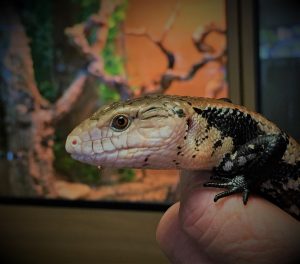Copyright 2021 Evolution Reptiles
All rights reserved.
Copyright 2025 Evolution Reptiles
All rights reserved.
All rights reserved.
The blue tongue skink is a large, robust skink found across Australia, New Guinea, and some of the surrounding Indonesian islands. As Australian species very rarely show up in the pet trade, the species most likely to be encountered is the Indonesian blue tongue, Tiliqua gigas. There are several subspecies and localities available, but overall care for them is generally the same.

Unlike their Australian counterparts, the Indonesian blue tongue is a tropical forest floor dweller. The aim, when setting up the vivarium, is to recreate this environment for your new pet. Even though you will (hopefully!) be buying a captive bred animal that has never seen the forests of Indonesia, your new pet has evolved to thrive in a very particular set of circumstances.
Allow plenty of space. A blue tongue can be a relatively large lizard, up to 55cm from nose tip to tail tip, so they like to have a reasonably large area to roam around. A wooden vivarium of 6’ x 2’ x 2’ will be suitable for a Blue tongue skink. They do enjoy the variety of lots of different things to hide under and scramble over, so do make sure to make the decor as varied and interesting as possible. Lots of logs and caves will keep them busy.
As a forest dwelling species, they like a fairly humid substrate. A mix of coir fibre and bark chips works well, as do any of the forest floor bio-active mixes available on the market. If you can cover that with a nice thick layer of leaf litter that will please your skink even more! A humidity range of 60-80% should be provided.
Good quality UVB lighting is a must. They are a Ferguson Zone 2-3 species, meaning they require a UVI range of 1.1 to 7.4.
Provide plenty of hides to give shaded areas, so the skink can escape the UVB if it wants to.
A basking area of 35-32c should be provided at one end of the vivarium. The cooler end of the vivarium should be kept around 25c. Like most reptiles, they will benefit from a temperature drop at night, which can drop down to 18ºc.
Feeding is simple. A tropical forest floor is full of good things to eat, and a blue tongue will make the most of them! They will take fruit, flowers, insects, eggs, and even rodents if they happen to come across a nest. To replicate this diet in captivity isn’t too difficult; if you stick to roughly 50% vegetables, 40% protein sources and 10% fruit you will be providing your skink with a balanced diet. Vegetables can be raw or lightly cooked, and all food should be dusted with a good calcium or multivitamin/multimineral powder. Protein sources can be either insects – live feeder insects will also stimulate your skink to run around to catch their dinner – although you can use low fat turkey mince, or finely chopped beef heart. Avoid citrus fruits, but berries, mangos and other soft fruits are fine. Experiment with lots of different ones to see what your skink likes best. They also enjoy eggs (raw or cooked, although cooked is less messy), and love snails. Don’t use snails from the garden, but if you have access to young African land snails your skink will thank you for them!
Most blue tongues are quite shy to start with, but regular gentle handling is tolerated well. Once your skink realises that you are not a predator and in fact are the source of tasty treats, they will begin to enjoy their exercise time out of the vivarium with you.
Copyright 2021 Evolution Reptiles
All rights reserved.